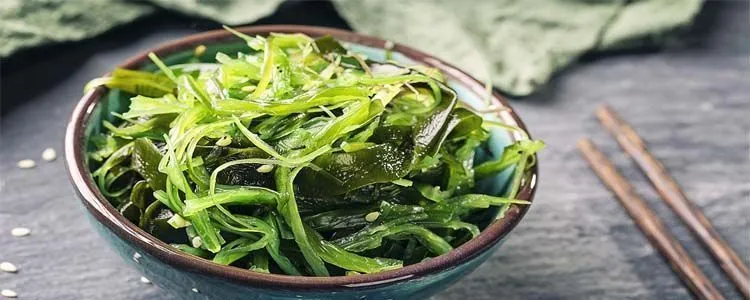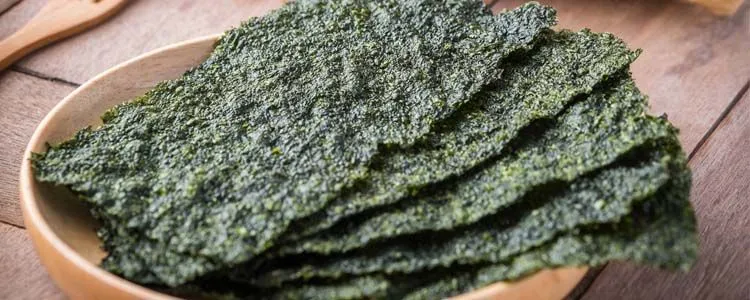Table of Contents
What exactly are edible algae?
Edible algae encompass a broad group of marine and freshwater species that can be used in food and do not contain toxic or harmful elements for humans.
These algae can develop in a wide range of waters, not necessarily marine. Although most are edible, there are some freshwater species that can become toxic, so they should be avoided and are not usually marketed.
We can classify them by species, although it is commonly done by color or size. We can find them from green or red color (the most common), although also blue and brown.
In Asian cuisine, especially Japanese, edible seaweed has been integrated for hundreds of years, and today they have become fashionable in the Western world thanks to dishes such as sushi or ramen.
Types and varieties of edible algae
Although we can find a large number of varieties of edible algae in the world, these are the most commercialized and common:
- Wakame: of green color, it is usual to use it to prepare fresh salads and dishes of stews and soups. It has a crunchy texture and enhances the flavor of the rest of the ingredients.
- Alga Nori: a red algae that is usually marketed in dry slices, commonly used to roll Japanese sushi.
- Chlorella: an edible green algae considered a superfood, which is usually marketed as a supplement through tablets or powder.
- Agar and carrageenan: are gelatinous substances used as thickeners and gelling agents in a wide variety of packaged and prepared products.
- Kombu: a little-known type of seaweed with a powerful flavor. It can be used as a soup additive or for use in pickles.
- Arame: It has a sweet taste and very soft to the palate. Due to its characteristics, it is usually used in a wide variety of dishes.
- Dulse: a red algae very easy to chew and soft texture. It is usually used to enhance the flavor in a large of dishes, although it is also marketed as an appetizer when allowed to dry.
- Kelp: of brown color, it is used once it has been allowed to dry, in the form of sheets, preferably in cooking dishes such as soups and stews.
- Sea lettuce: a type of green nori well known in the Western world, characteristic for being shaped like lettuce. Therefore, it is usually used in the preparation of salads or even cooked in stews.
Nutritional composition of algae
Given the wide variety of edible algae that we can find, the nutritional composition changes between them. However, we wanted to group by rank the main characteristics that it can provide us.
The advantages of many of the seaweed is that they have a composition similar to many terrestrial vegetables, but with greater mineral accumulation and biologically active substances.
100 grams of algae can provide us with the following nutrients, according to the USDA:
- Energy: 45 kcal
- Protein: 0 %
- Carbohydrates: 10 g
- Fibre: 14–35% of the RDA
- Grease: 1 g
Minerals (RDA recommended daily allowance)
- Potassium: 1-45% of the COR
- Magnesium: 27–180% of the CoR
- Iron: 3–20% of the COR
- Manganese: 10–70% of the COR
- Copper: 6–15% of the COR
- Iodine: 1–65% of the RDA
- Sodium: 10–70% of the COR
- Calcium: 15–60% of the RDA
Vitamins (RDA recommended daily allowance)
- Vitamin k: 7–80% of the CoR
- Vitamin B (folate): 45–50% of the RDA
It also contains less significant amounts of other elements such as vitamins A, B, C, vitamin E, omega 3 and omega-6 fatty acids, minerals such as phosphorus, choline and sulfated polysaccharides (sPS)
In general, dried algae increase their nutrient concentration by losing water, although it also lowers the potential of their biological principles. The edible algae that have the highest concentration of proteins are the chlorella and the spirulina. Often usedThey are used as a complementary source of protein in the form of capsules or powders.
Beneficial properties of edible algae

Algae promote thyroid function
The thyroid is a very important gland in the body, since it plays several essential roles in the regulation of metabolism.
In it, it is important to cover the basic needs of iodine (150 mcg daily, according to USDA), since it is closely related to the proper functioning of the thyroid. This mineral can be found in significant amounts in most edible algae (and also in dairy products, seafood and in the iodized salt itself).
Insufficient intake of the mineral iodine may be related to the causes of hypothyroidism, causing symptoms of lack of energy, weight gain and depression, among others.
The varieties of algae of edible type that offer the highest concentration in iodine are the dulse type and kombu. On the other hand, spirulina usually has a low concentration in this mineral.
May benefit the cardiovascular system
Edible seaweed contains different nutrients that act directly on heart health.
Interesting is its high concentration in soluble fiber, where we also find omega 3 and 6 fatty acids essential for the cardiovascular system.
The presence of the so-called sulfated polysaccharides present in edible algae directly influence blood pressure and act as a preventive against blood clotting.
There are different scientific studies that relate the consumption of algae with the decrease in total cholesterol (due to the lowering of the bad or LDL). [See studys], and in turn, is related to the decrease in blood pressure in children, adults and the elderly.
The spirulina consumption in patients with type 2 diabetes it reflected a noticeable decrease in triglyceride level (up to 24%) compared to patients taking placebo. [See study]
In fact, there are more than 10 international studies where it is seen that spirulina offers a multitude of advantages in reducing cholesterol, triglycerides and LDL.
May regulate blood glucose levels
Diabetes is one of the main problems worldwide, especially in the West, and day after day natural solutions are sought through the consumption of functional foods and the improvement of the diet.
In particular, seaweed may offer potential to regulate and balance blood sugar spikes, something very valuable in patients suffering from diabetes.
Some biologically active compounds have been located in this type of algae that trigger positive reactions that improve blood sugar regulation. One of these compounds is known as Fucoxanthin, an antioxidant in the form of a brown pigment that characterizes the color of many algae.
This element is currently being studied for its potential to stabilize blood glucose concentration.
Some scientific trials have attributed up to a 15 to 20% reduction in glucose levels compared to placebo, also acting on insulin sensitivity by 8%.
This helps improve the sugar regulation response, preventing high and low peaks from occurring.
On the other hand, it is necessary to address more fair dosing to obtain the maximum benefits without added side effects, so there is still a wide path in research.
Edible algae can regulate body weight
The habitual presence of algae in our diet can reduce body weight based on reducing the feeling of hunger and indirectly replace the consumption of foods rich in fat and carbohydrates.
The high presence of soluble fibers slows down digestion, as well as increases the feeling of filling, reducing the caloric volume we take daily.
This weight-reducing effect has been proven in studies carried out on obese patients, where after 16 weeks of research, a lost weight gain of 1.6 kg was found compared to placebo.
Algae help strengthen the immune system

Foods high in antioxidants favor protecAgainst different types of infections. The answer lies in the sulfated polysaccharides, with antioxidant, antiallergic, anticancer and anticoagulant activity.
This compound can be found in different concentrations and nature depending on the edible algae:
- Ulvanos in green algae
- Carrageenans in red algae
- Fucoidans in brown algae
In some Asian algae the presence of sulfated polyanions and other components with antiviral activity, offering good response against herpes simplex type 1 and herpes type 2 infections.
Although the consumption of these compounds present in different Asian algae is related to a higher cure rate after herpetic outbreaks, more research is still needed to know the best species and dosage.
Algae activate the digestive system
There is a clear relationship between the fiber concentration of a food and its potential to improve gut health. This compound prevents constipation and ensures smooth digestion.
The prebiotic activity Present in this food also guarantees the presence of bacteria considered beneficial in our stomach and intestines. This, in turn, ensures a lower presence of pathogenic microorganisms such as Helicobacter pylori.
May reduce the risk of cancer
When we talk about foods that cure cancer, we often throw our hands to our heads, and rightly so. In this case, we must talk about cancer prevention, and this has been demonstrated with various foods and active ingredients.
Specifically, the edible seaweed provided in our diet can help prevent the development of various types of cancer, specifically breast cancer.
In turn, foods rich in fiber favor the chances of suffering from color cancer, as we have commented in some articles on our website, something that has been scientifically proven.
The highest concentration of these potentially active elements against cancer are found in algae such as kombu or wakame.
However, they are still in the process of scientific review and confirmation by the entire medical community.
Products based on edible algae
Is it safe to eat edible seaweed?
Once the beneficial properties of the consumption of edible algae have been analyzed, are they safe or can they cause food allergies?
In general, most of them have been approved by health agencies, although it depends on the collection area and conservation, which can have side effects.
These contraindications can be related to the presence of heavy metals, active ingredients that interfere with medications, or hormones that affect the function of the thyroid gland.
May contain high levels of heavy metals
Depending on the growing area of these edible algae, they can have high levels of heavy metals such as cadmium, lead, arsenic or mercury. Therefore, we should only rely on buying them from specialized sites and with a guarantee.
May interfere with blood thinners
Some varieties contain high levels of vitamin k, which can hinder the activity of anticoagulant drugs. However, to suffer from this problem, we must take high amounts of algae.
May interfere with thyroid function
Although iodine is essential for the proper functioning of the thyroid gland, an excess can cause alterations. Some varieties contain high concentrations, and we can exceed the recommended daily amount.
